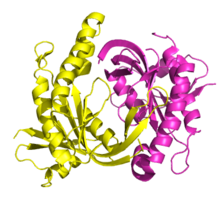Guanylate cyclase
| Guanylyl cyclase | |||||||||
|---|---|---|---|---|---|---|---|---|---|

|
|||||||||
| Identifiers | |||||||||
| EC number | 4.6.1.2 | ||||||||
| CAS number | 9054-75-5 | ||||||||
| Databases | |||||||||
| IntEnz | IntEnz view | ||||||||
| BRENDA | BRENDA entry | ||||||||
| ExPASy | NiceZyme view | ||||||||
| KEGG | KEGG entry | ||||||||
| MetaCyc | metabolic pathway | ||||||||
| PRIAM | profile | ||||||||
| PDB structures | RCSB PDB PDBe PDBsum | ||||||||
| Gene Ontology | AmiGO / EGO | ||||||||
|
|||||||||
| Search | |
|---|---|
| PMC | articles |
| PubMed | articles |
| NCBI | proteins |
Guanylyl cyclase (EC 4.6.1.2, also known as guanyl cyclase, guanylate cyclase, or GC) is a lyase enzyme. Guanylyl cyclase is often part of the G protein signaling cascade that is activated by low intracellular calcium levels and inhibited by high intracellular calcium levels. In response to calcium levels, guanylyl cyclase synthesizes cGMP from GTP. cGMP keeps cGMP-gated channels open, allowing for the entry of calcium into the cell. Like cAMP, cGMP is an important second messenger that internalizes the message carried by intercellular messengers such as peptide hormones and NO, and can also function as an autocrine signal. Depending on cell type, it can drive adaptive/developmental changes requiring protein synthesis. In smooth muscle, cGMP is the signal for relaxation, and is coupled to many homeostatic mechanisms including regulation of vascular and airway tone, insulin secretion, and peristalsis. Once formed, cGMP can be degraded by phosphodiesterases, which themselves are under different forms of regulation, depending on the tissue.
Guanylyl cyclase catalyzes the reaction of guanosine triphosphate (GTP) to 3',5'-cyclic guanosine monophosphate (cGMP) and pyrophosphate:
Guanylyl cyclase is found in the retina (RETGC) and modulates phototransduction in rods and cones. It is part of the calcium negative feedback system that is activated in response to the hyperpolarization of the photoreceptors by light. This causes less intracellular calcium, which stimulates guanylyl cyclase-activating proteins (GCAPs). Studies have shown that cGMP synthesis in cones is about 5-10 times higher than it is in rods, which may play an important role in modulating cone adaption to light. In addition, studies have shown that zebrafish express a higher number of GCAPs than mammals, and that zebrafish GCAPs can bind at least three calcium ions.
...
Wikipedia
